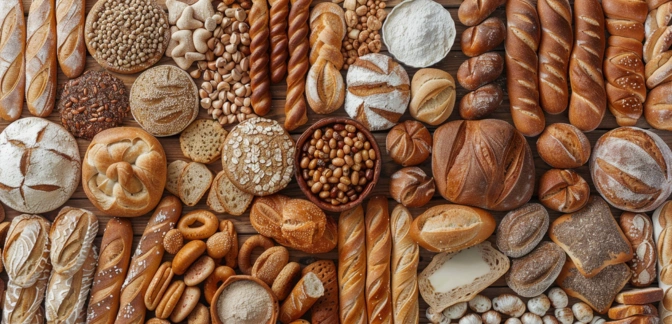Seed Bread — Nutrients, Health Benefits, And Shopping Tips

Written by Listonic Team
Last update on September 4, 2024
Seed bread nutrients
Nutrition facts
Amount per 100 g
Calories
🔥 264 kcal
| Nutrition per: 100 g | Value | % Daily Value* |
|---|---|---|
| Carbs | 43 g | 15.64% |
| Fiber | 8 g | 28.57% |
| Sugars | 4 g | 8% |
| Glycemic Index | 50 | - |
| Protein | 13 g | 26% |
| Sodium | 422 mg | 18.35% |
| Total Fat | 4 g | 5.13% |
*The % of Daily Value (DV) tells you how much a nutrient in a serving of food contributes to a daily diet. 2,000 calories a day is used for general nutrition advice.
13 g
🧀 Good Protein Content
8 g
🥔 Good Fiber Content
Seed bread facts & tips
Health benefits
- Rich in fiber, supporting digestive health, promoting regular bowel movements, and maintaining a healthy gut microbiome.
- High in healthy fats from seeds such as flax, chia, and sunflower, which support heart health and provide essential fatty acids.
- Contains essential vitamins and minerals such as magnesium, zinc, and B vitamins, which support overall health and well-being.
- Provides sustained energy from complex carbohydrates and protein, making it a nutritious and filling option.
Health risks
- High calorie content due to the seeds, which can contribute to weight gain if consumed in large quantities, particularly as a snack or part of a calorie-dense meal.
- High fat content though mostly healthy fats, excessive consumption can still contribute to increased caloric intake and weight gain.
- Potential for allergic reactions in individuals allergic to seeds, nuts, or grains, causing symptoms like itching, swelling, or difficulty breathing.
- Potential for digestive discomfort such as bloating or gas when consumed in large quantities due to the high fiber content from the seeds.
How to choose seed bread
Seed bread should be dense yet soft, with a variety of visible seeds distributed evenly throughout each slice. The crust should be golden and crisp, adding a satisfying texture.
Do not choose seed bread that is overly hard or has a very dry texture, as this can indicate it is stale. Bread that smells sour or has visible mold growth should also be avoided.

How to store seed bread
Seed bread should be stored in a cool, dry place, ideally in a bread box or airtight container. This helps keep it fresh and prevents it from drying out. For longer storage, consider freezing the bread.
Exposure to air can cause seed bread to become stale quickly. Avoid storing it in the refrigerator, as this can dry it out. Always wrap the bread tightly and consume within a few days for the best texture and flavor.
✅ Extra Tip
How long does it last?
Seed bread can last for 3-5 days at room temperature when stored in an airtight container. For longer storage, seed bread can be frozen for up to 3 months.
What to do with leftovers?
Leftover seed bread can be used in a variety of savory and sweet dishes. Toast it and serve with butter, jam, or honey for a quick breakfast, or use it as a base for sandwiches or bruschetta. Seed bread is also great when used to make croutons by cubing, tossing with olive oil and seasonings, and baking until crispy.
Use leftover seed bread to make a bread pudding by tearing it into pieces and mixing with eggs, milk, and spices, then baking until set. If you have a lot of seed bread, consider using it to make grilled cheese sandwiches with your favorite cheese and toppings, or as a base for open-faced sandwiches with smoked salmon, avocado, or hummus. Seed bread can also be blended into breadcrumbs for coating meats or vegetables, or used as a thickener in soups and stews. For a quick snack, enjoy seed bread with cheese, cold cuts, or a spread like peanut butter or Nutella.
👨⚕️️ Medical disclaimer
Discover products from other categories
Listonic Team
Fact-checked
Our editorial team checked this article to make sure it was accurate at the time of publishing it.
Get the top-rated shopping list app

seed bread
1 piece
Outline







